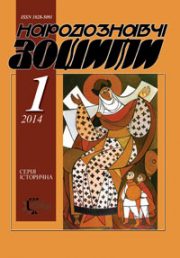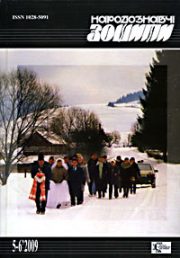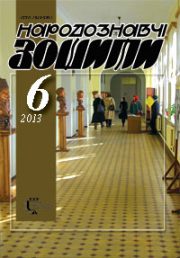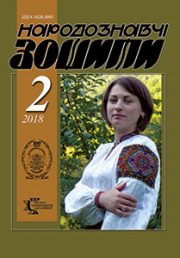The Ethnology Notebooks. 2019, 2 (146), 303—318
UDK 398. 332. 33:631. 55-051 (477. 7/. 8=161. 2)
DOI https://doi.org/10.15407/nz2019.02.303
KONOPKA Volodymyr
ORCID ID: https://orcid. org/0000-0003-0872-1833
Ph.D. of Sciences in History,
Researcher of the Institute of Ethnology
of the Nationa Academy of Sciences of Ukraine,
in the Department of Historical Ethnology,
Svobody Avenue 15, 79000, Lviv, Ukraine.
Contacts: e-mail: grafalf@gmail.com
Abstract. The agricultural theme is one of the main issues in the folkcalendar of Ukrainians. Therefore, the clarification of the main motifs of individual calendar periods is very relevant today. The goal of author is to analyze separate rituals or their elements, which are aimed at ensuring the harvest of cereals in the Christmas-Candlemas period. The object of research is the calendar ritual, as a component of the folk culture of Ukrainians. The subject is the agricultural motifs in the system of calendar customs and rituals, in particular their substantive, focal and verbal forms. The methodological basis of work is in the principles of objectivity and historicism. The methodology of V. Propp and the ethnolinguistic school of M. Tolstoi were used to study the agricultural motifs. To form a source base, bush and route ethnographic expeditions were conducted, during which the material was recorded with the help of an oral interview of respondents according to a pre-prepared questionnaire. The agricultural theme in the Christmas-Candlemas period is not sufficiently highlighted in special scientific research. This aspect is covered by the authors rather superficially, without proper analysis; therefore the author’s field materials are the basis of the work.
Agriculture – one of the main occupations of Ukrainian peasants. Its spiritual aspect is expressed through calendar and occasional ceremonies. Sources of grain-farming motives in the calendar rituals of Ukrainians reach the period before the settlement of the Slavs. They began to form simultaneously with the active development of arable crops growing, as evidenced first of all by linguistic data and comparative ethnographic material of Slavic ethnoses (organic affinity of all-Ukrainian and general Slavic).
In the Christmas-Candlemas period, the agricultural motifs are manifested primarily through the rites and customs associated with the attributes of harvesting (a «snip», a «vinok», straw, sprouts) and cereals («kutia», porridge, bread, ritual pastry). At holidays, Ukrainian peasants followed behavioural stereotypes, which were traditionally defined, believing that the yield of cereals could be ensured in this way (which in the classical peasant society meant family prosperity in the following year). Magical actions in the winter calendar ritual (in particular, «feeding», imitation, divination and ritual obviations) are primarily aimed at forecasting and inducing yields.
Keywords: agricultural motifs, a folk calendar, the South-Western HistoricEthnographic Macro-region of Ukraine, a ritual, a custom, grain harvesting attributes, harvest.
Received 8.02.2019
REFERENCES
Duchiminska, O. (1937). Christmas customs in the village of Tyapchi. Women’s fate, 1—2, 3—4. Kolomiya [in Ukrainian].
Duchiminska, O. (1939). Christmas customs in the village of Vovchim, Tuchan district. Women’s fate, 1—2, 11—12. Kolomiya [in Ukrainian].
Zubrytsky, M. (1900). Folk calendar, folk customs and verifications tied to days in the weeks and festive holidays (Recorded in Mshantsy, Staromisky district and in neighboring villages). In Materials for the Ukrainian-Ruthenian ethnology (Vol. III, pp. 33—60). Lviv [in Ukrainian].
Turyanska, M. (1934). Boyk’s customs of the Christmas holidays, New Year and Jordan. In Chronicle of Boykivshchyna (Vol. IV, ch. 3, pp. 23—27). Sambir [in Ukrainian].
Halaychuk, V. (2010). Traditional calendar customs and rites of Starosambirschyna. In The Notes of the NTSh (Vol. CCLIX, pp. 138—178). Lviv [in Ukrainian].
Zborovsky, P. (2008). The Christmas cycle of holidays according to the tradition of the village Verkhne Vysotskoe on the Turkivshchyna. The Ethnology Notebooks, 1—2, 49—53 [in Ukrainian].
Konopka, V. (2012). Agricultural motives Christmas-Epiphanie cycle celebrations in Boikivshchyna. In Fortress: scientific collection of the «Tustan» Reserve (Vol. 2, pp. 594—610). Lviv [in Ukrainian].
Benkovsky, I. (1896). Beliefs, customs, rituals, superstitions and signs, marked by the «Christmas». Kievskaya starina (Vol. LII, book 1, div. II, pp. 1—9). Kiev [in Russian].
Benkovsky, I. (1889). Christmas holidays in Volyn. Kievskaya starina (Vol. ХХІV, book 1, pp. 236—242). Kiev [in Russian].
Kondratovych, O.P. (2009). The folk calendar of Volyn Polissya from the holiday to the holiday. Lutsk: OJSC Volyn Regional Printing House [in Ukrainian].
Savka, M. (2012). Agricultural motifs in the winter ritual of Ukrainians in Volhynia (based on the materials of the Gorokhov district of the Volyn region). The Ethnology Notebooks, 5, 839—844 [in Ukrainian].
Onishchuk, A. (1912). Folk calendar. Customs and beliefs are tied to the unparalleled days of the year, recorded in 1907—10 in Zelenitsy, Nadvirnyansky district. In Materials for the Ukrainian-Ruthenian ethnology (Vol. XV, pp. 1—61). Lviv [in Ukrainian].
Shekeryk-Donykiv, P. (2009). Year in the beliefs of Hutsuls. Selected works. Verkhovyna [in Ukrainian].
Shukhevych, V. (1904). Huzulschyna. Part 4. Materials for the Ukrainian-Ruthenian ethnology (Vol. VII, pp. 1—272). Lviv [in Ukrainian].
Kutelmah, K. (1987). Calendar rites. In Huzulschyna: historical and ethnographic research (pp. 286—302). Kiev [in Ukrainian].
Horbal, M. (2012). «Didukh» («did»), kutya in the Christmas ritual of Lemkivshchyna. Typology and semantics. The Ethnology Notebooks, 2, 218—226 [in Ukrainian].
Horbal, M. (2008). Christmas lights in rituals of Lemkos. The Ethnology Notebooks, 1—2, 40—48 [in Ukrainian].
Horbal, M. (2006). Bread in Christmas rite of Lemkos. The Ethnology Notebooks, 1—2, 126—131 [in Ukrainian].
Krasovskyy, I., & Varkhol, Y. (2002). Calendar rites. In Lemkivshchyna: Historical and ethnographic research (Vol. 2, pp. 113—123). Lviv [in Ukrainian].
Pasternak, Y. (1929). Customs and beliefs in Zibolky Zhovkva district. Materials for the Ukrainian-Ruthenian ethnology (Vol. ХХІ—ХХІІ, part 1, pp. 321—352). Lviv [in Ukrainian].
Roman, S. (2012). Christmas ceremony of Ukrainians of Zhydachivshchyna (based on materials of ethnographic expeditions). The Ethnology Notebooks, 1, 143—149 [in Ukrainian].
Kolberg, O. (1962). Pokuttia: An ethnographic picture. In Works (Vol. 29). Wroclaw; Poznaс [in Polish]
Kolberg, O. (1963). Pokuttia: ethnographic image. In Works (Vol. 31). Wroclaw; Poznaс [in Polish].
Kurochkin, O.V. (1994). Rites (calendar holidays and ceremonies). In Podillya: Historical and ethnographic research (pp. 358—385). Kyiv [in Ukrainian].
Tvorun, S.O. (2006). Ukrainian ritual breads: on materials of Podillya. Vinnytsya [in Ukrainian].
Tvorun, S.O. (2009). Practical Ethnology for Business People: Teach. Manuals. Vinnitsa [in Ukrainian].
Kayndl, R.F. (2000). Gutsuli: their life, traditions and people’s remittances. Chernivtsi [in Ukrainian].
Kupchanko, G. (1875). Some historical and geographical information about Bukovina. Kiev [in Russian].
Moysey, A.A. (2008). Magic and mantis in the folk calendar of the East-Romanian population of Bukovina. Chernivtsi [in Ukrainian].
Moysey, A.A. (2010). Agrarian customs and ordinances in the folk calendar of the East-Romanian population of Bukovina. Chernivtsi [in Ukrainian].
Hrushevsky, M.C. (1993). History of Ukrainian literature (Vol. 1). Kiev [in Ukrainian].
Petrushevych, A.S. (1863). Public journal of church, folk, family and governmental activities, superstitions and divinations. Lvov [in Russian].
Chekhovsky, I.G. (2001). Demonological beliefs and folk calendar of Ukrainians in the Carpathian region. Chernivtsi [in Ukrainian].
Onishchuk, A. (1909). Materials to Hutsul demonology. Recorded in Zelenitsy Nadvirna district in 1907—1908. In Materials for the Ukrainian-Ruthenian ethnology (Vol. XI, pp. 1—139). Lviv [in Ukrainian].
Schnaider, J. (1907). Peczeniїyсski people: ethnographic sketch. People: Ethnographic Quarterly (Vol. XIII, part 1, pp. 21—33). Lwьw
Naulko, V.I. (Ed.). (1993). Culture and Life of the Population of Ukraine. Kiev [in Ukrainian].
Konopka, V. Field ethnographic materials to the theme «Agricultural motives in Ukrainian ritual calendar», recorded in Bohorodchany district of Ivano-Frankivsk region. 11—22.07.2008. In Archive of Lviv National Ivan Franko University. F. 119. Op. 17. Sp. 250-E. 110 arcs [in Ukrainian].
Blin-Olbert, D. (1994). Rokobrzкdowy u іemkуw (polish). In Lemks in the history and culture of the Carpathians (Vol. II, pp. 313—349). Sanok [in Polish].
Bogatyrev, P.G. (2007). «Polaznik» among the southern Slavs, Magyars, Slovaks, Poles and Ukrainians. In Folk culture of the Slavs. Moscow [in Russian].
Koperzhynsky, K. (1930). Calendar of folk ceremonies of the New Year cycle. In Primary citizenship and its remnants in Ukraine (Vol. 3, pp. 14—98). Kyiv [in Ukrainian].
Kurochkin, O.V. (1978). New Year holidays of Ukrainians: Traditions and the present. Kiev [in Ukrainian].
Propp, V.Ya. (1995). Russian agrarian holidays. St. Petersburg [in Russian].
Konopka, V. Field ethnographic materials to the theme «Agricultural motives in Ukrainian ritual calendar», recorded in Volovets district of the Transcarpathian region. 22—23.06.2011. In Archive of the Institute of Ethnology of the National Academy of Sciences of Ukraine. F. 1. Op. 2. Od. save 624. 49 arcs [in Ukrainian].
Konopka, V. Field ethnographic materials to the theme «Agricultural motives in Ukrainian ritual calendar», recorded in Kamianka-Buzka and Busk district of Lviv region. 6—8. 07.2012. In Archive of the Institute of Ethnology of the National Academy of Sciences of Ukraine. F. 1. Op. 2. Od. save 674. 40 arcs [in Ukrainian].
Konopka, V. Field ethnographic materials to the theme «Agricultural motives in Ukrainian ritual calendar», recorded in the Putyla district of Chernivtsi region. 25—27.05.2013. In Archive of the Institute of Ethnology of the National Academy of Sciences of Ukraine. F. 1. Op. 2. Od. save 697. 51 arcs [in Ukrainian].
Konopka, V. Field ethnographic materials to the theme «Agricultural motives in Ukrainian ritual calendar», recorded in Terebovlya, Pidvolochysk and Ternopil district of the Ternopil region. 18—20.08.2009. In Archive of Lviv National Ivan Franko University. F. 119. Op. 17. Sp. 305. 64 arcs [in Ukrainian].
Ogienko, I. (1992). The pre-Christian beliefs of the Ukrainian people: historical and religious monograph. Kiev [in Ukrainian].
Gromova, N. (2006). Holy evening in modern Boyko village. In Ethnic history of the peoples of Europe (Vol. 21, pp. 89—96). Kyiv [in Ukrainian].
Kurochkin, O. (1993). Holidays and rituals of the calendar cycle. In Ukrainian past: an illustrated ethnographic guide (pp. 182—200). Kyiv [in Ukrainian].
Kuharonok, T. (2008). Traditional folk calendar of Ukrainians in Belarus: According to the materials of modern field research. Ethnic history of the peoples of Europe (Vol. 26, pp. 54—60). Kyiv [in Ukrainian].
Kutelmakh, K. (2006). Calendar ritual as an ethnogenetic source. In Ethnogenesis and ethnic history of the Ukrainian Carpathians (Vol. 2, pp. 473—557). Lviv [in Ukrainian].
Kurochkin, O. (1995). Ukrainian Christmas ceremonies «goat» and «Malanka». Opishne [in Ukrainian].
Dymnycz, N. (1930). Rites and folk beliefs during Christmas (Village Borszezуwka, commune Borsuki, district Krzemicniecki on Wolyn). Volhyn Yearbook, 1, 94—106. Rowne [in Polish]
Halaychuk, V. (2009). Christmas-Epiphanie holidays around Kremenets. Visnyk of Lviv University. Series history, 44, 215—240 [in Ukrainian].
Yarosh, T.M. Field ethnographic materials for the theme «Winter calendar ritual», collected in the Starosambir district of the Lviv region. 8—19.07.2005. In Archive of Lviv National Ivan Franko University. F. 119. Op. 17. Sp. 133. 37 arcs [in Ukrainian].
Lozynska, I. (2001). Grain in winter rituals of Ukrainians. In Ethnic history of the peoples of Europe (Vol. 10, pp. 70—75). Kyiv [in Ukrainian].
Zdoroveha, N.I. (1983). Folk customs and rituals. In Boykivschyna: Historical and ethnographic research (pp. 232—238). Kiev [in Ukrainian].
Skurativsky, V.T. (2005). Ukrainian folk calendar. Kyiv [in Ukrainian].
Kmit, Y. (1935). Still about Volosatyy. In Litopys of Boykivshchyna (Vol. V, ch. 6, pp. 1—9). Sambir [in Ukrainian].
Falkowski, J. (1937). Western border of the Hutsul region: Prut valleys, Bystrzyca Nadwуrniaсska, Bystryca Solotvanskja Lomnica. Lviv [in Polish].
Voropay, O. (1991). Customs of our people. Ethnographic essay (Vol. 1). Kyiv [in Ukrainian].
Kutelmakh, K. (2006). Polisko-Carpathian parallels in the all-Ukrainian calendar-ritual sphere. The Ethnology Notebooks, 3—4, 328—337 [in Ukrainian].
Bilyakovskyy, P. (2012). Christmas-cycle Sretensky weather predictions in the national calendar of Ukrainian Carpathians. The Ethnology Notebooks, 4, 634—642 [in Ukrainian].
Kolberg, O. (1964). Przemyskie. In Works (Vol. 35). Krakow [in Polish].
Kolberg, O. (1976). Red Rus: Ethnographic picture. In Works (Vol. 56). Wroclaw; Poznaс [in Polish].
Vinogradova, L.N. (1982). Winter calendar poetry of the Western and Eastern Slavs. Genesis and typology of caroling. Moscow [in Russian].
Glushko, M. (2011). «Children’s» carols and generations of Middle Polissya (from posts chornobyl recordings). Mythology and folklore, 1, 51—63 [in Ukrainian].
Krut, Yu.Z. (1973). Farming ceremonial poetry of the Slavs. Kyiv [in Ukrainian].
Motrescu, O. (1999). Rituals with a plow in the New Year’s ritual of Moldovan and RomanianBukovina. In Ethnic history of the peoples of Europe (Vol. 2, pp. 49—51). Kyiv [in Ukrainian].







